Causes, Policies, and Trends: Australia Unemployment
VerifiedAdded on 2023/01/13
|10
|2873
|80
Report
AI Summary
This report provides a comprehensive analysis of unemployment in Australia. It begins with an introduction defining unemployment and its measurement through the unemployment rate. The main body delves into unemployment in developed economies, exploring frictional, structural, and cyclical causes. The report examines how unemployment is measured in Australia, referencing the Australian Bureau of Statistics (ABS) and its Labour Force Survey. It then details the specific causes of unemployment in Australia, including seasonal, demand-deficient, frictional, and institutional factors, along with the role of real wages and technological advancements. The report also discusses the relationship between inflation and unemployment, referencing the Phillips curve. Finally, it concludes by summarizing the key findings and discussing policies aimed at minimizing unemployment in Australia, offering insights into the complex interplay of economic factors and governmental interventions. The report is a valuable resource for understanding the current state and underlying dynamics of Australia's labor market.
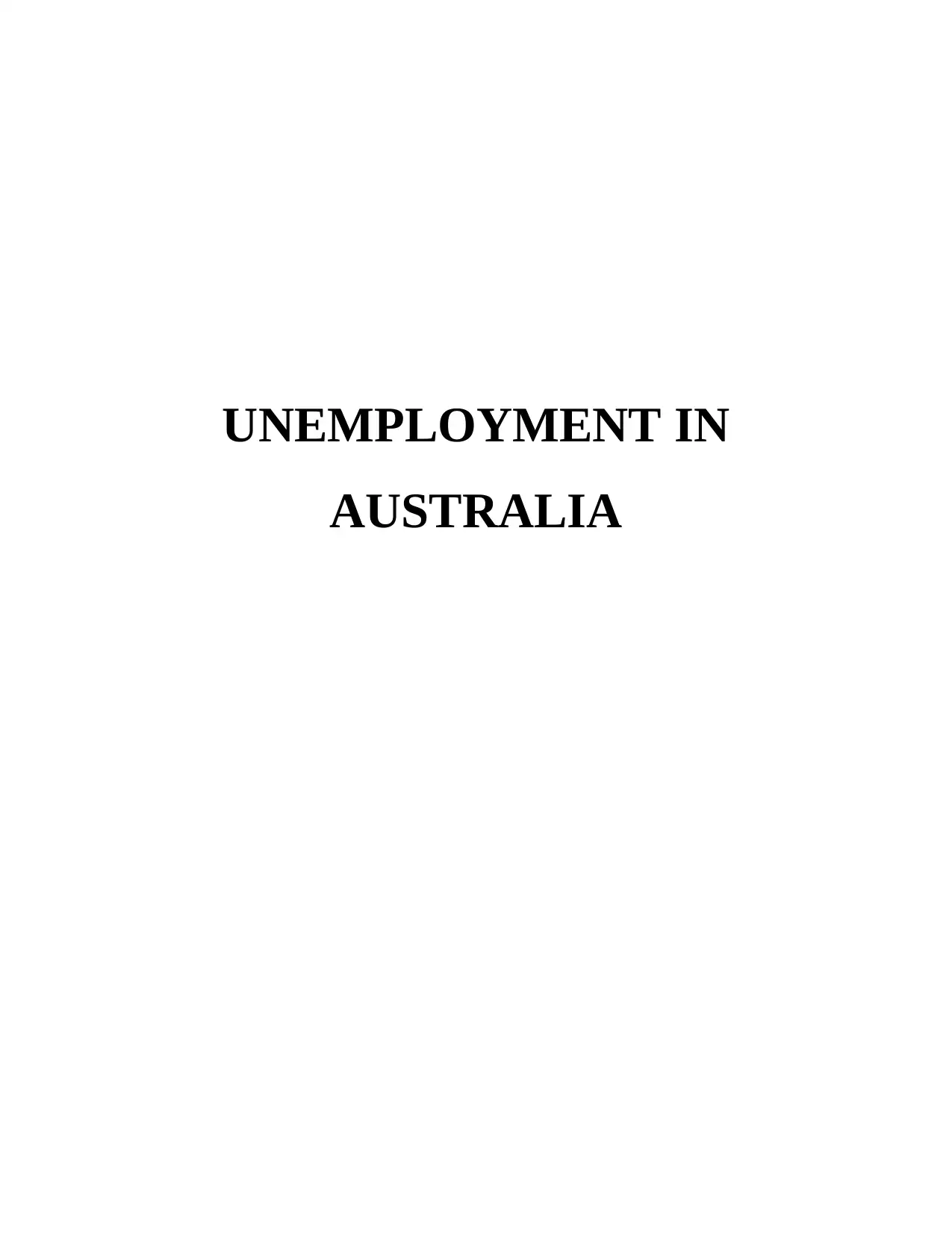
UNEMPLOYMENT IN
AUSTRALIA
AUSTRALIA
Paraphrase This Document
Need a fresh take? Get an instant paraphrase of this document with our AI Paraphraser
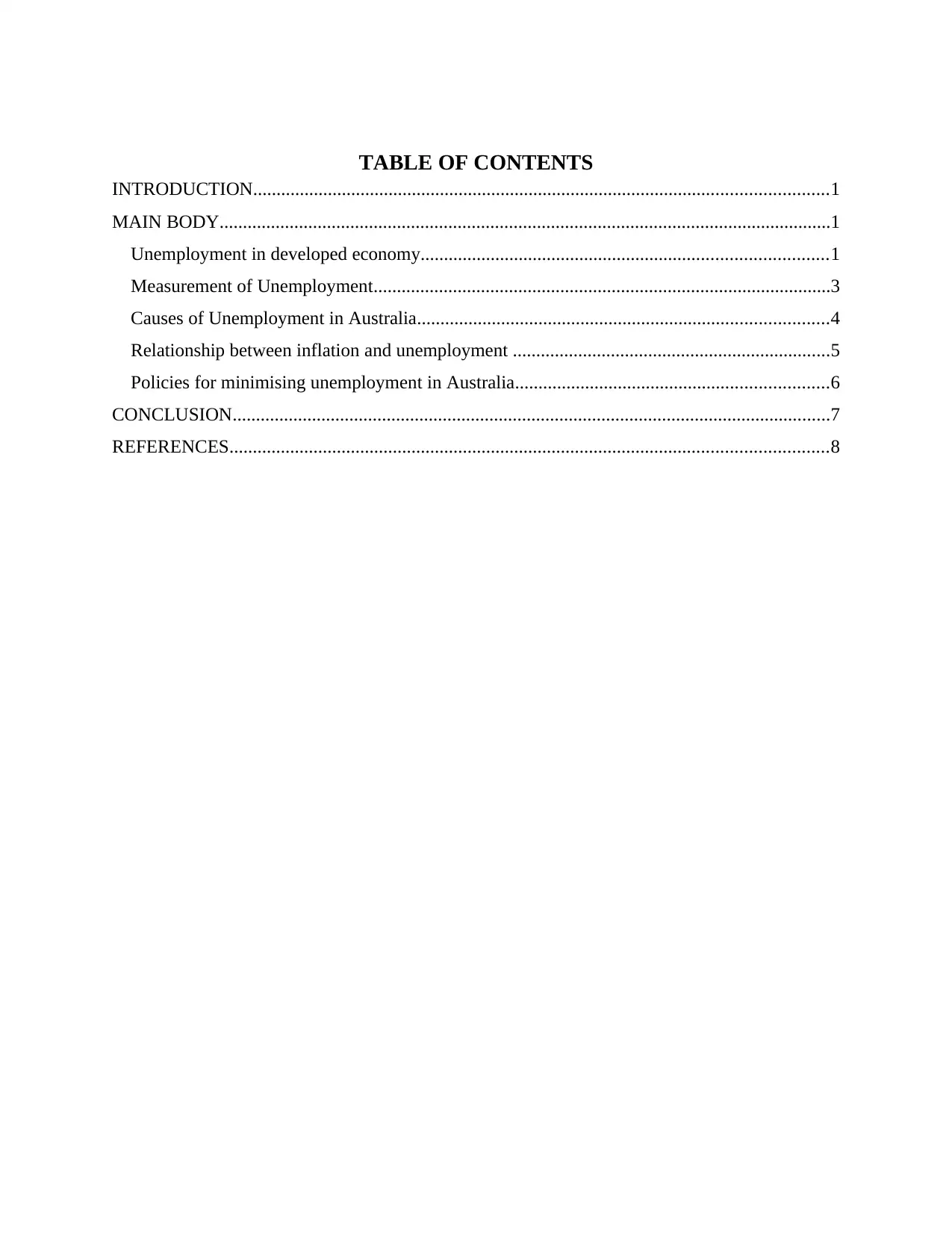
TABLE OF CONTENTS
INTRODUCTION...........................................................................................................................1
MAIN BODY...................................................................................................................................1
Unemployment in developed economy.......................................................................................1
Measurement of Unemployment..................................................................................................3
Causes of Unemployment in Australia........................................................................................4
Relationship between inflation and unemployment ....................................................................5
Policies for minimising unemployment in Australia...................................................................6
CONCLUSION................................................................................................................................7
REFERENCES................................................................................................................................8
INTRODUCTION...........................................................................................................................1
MAIN BODY...................................................................................................................................1
Unemployment in developed economy.......................................................................................1
Measurement of Unemployment..................................................................................................3
Causes of Unemployment in Australia........................................................................................4
Relationship between inflation and unemployment ....................................................................5
Policies for minimising unemployment in Australia...................................................................6
CONCLUSION................................................................................................................................7
REFERENCES................................................................................................................................8
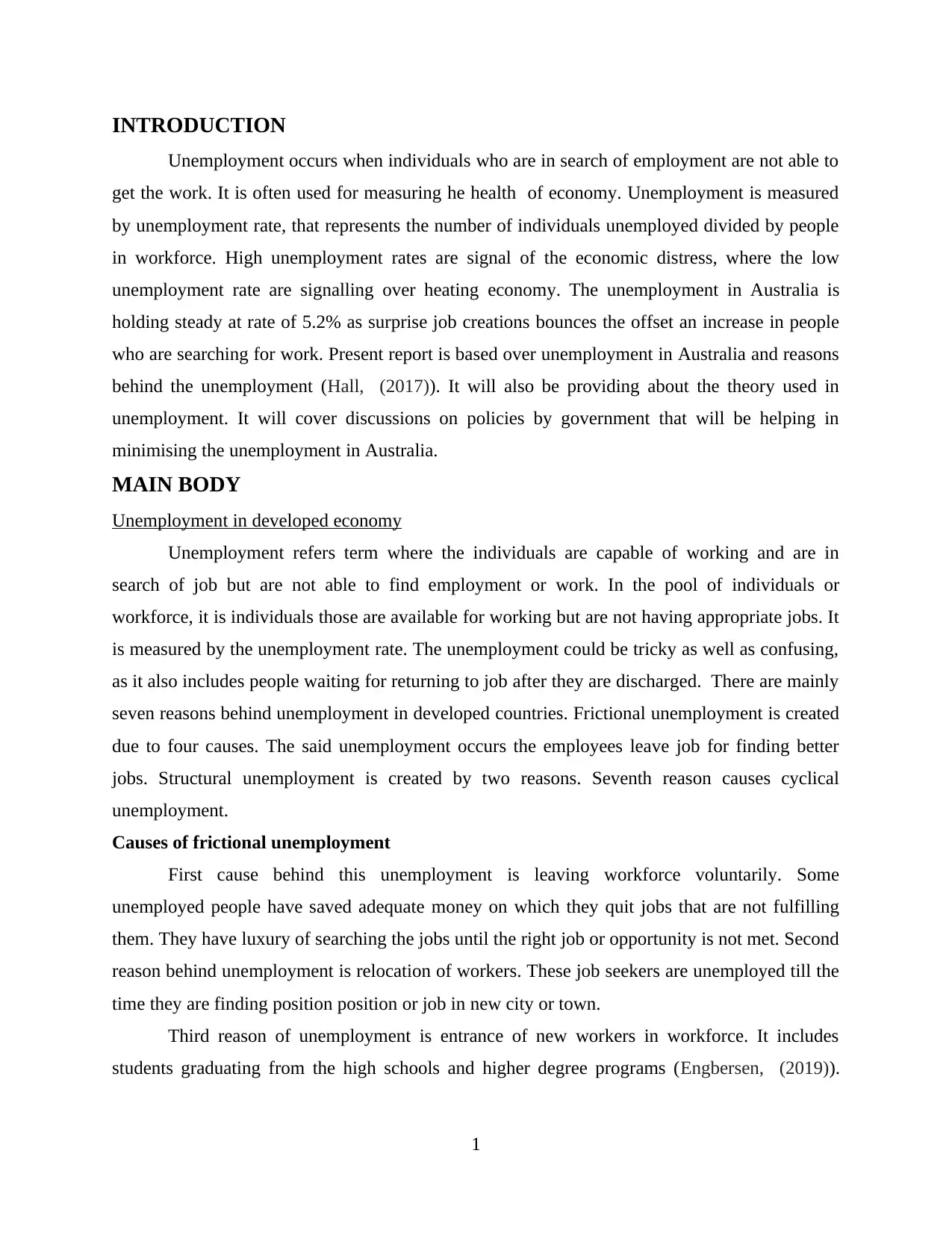
INTRODUCTION
Unemployment occurs when individuals who are in search of employment are not able to
get the work. It is often used for measuring he health of economy. Unemployment is measured
by unemployment rate, that represents the number of individuals unemployed divided by people
in workforce. High unemployment rates are signal of the economic distress, where the low
unemployment rate are signalling over heating economy. The unemployment in Australia is
holding steady at rate of 5.2% as surprise job creations bounces the offset an increase in people
who are searching for work. Present report is based over unemployment in Australia and reasons
behind the unemployment (Hall, (2017)). It will also be providing about the theory used in
unemployment. It will cover discussions on policies by government that will be helping in
minimising the unemployment in Australia.
MAIN BODY
Unemployment in developed economy
Unemployment refers term where the individuals are capable of working and are in
search of job but are not able to find employment or work. In the pool of individuals or
workforce, it is individuals those are available for working but are not having appropriate jobs. It
is measured by the unemployment rate. The unemployment could be tricky as well as confusing,
as it also includes people waiting for returning to job after they are discharged. There are mainly
seven reasons behind unemployment in developed countries. Frictional unemployment is created
due to four causes. The said unemployment occurs the employees leave job for finding better
jobs. Structural unemployment is created by two reasons. Seventh reason causes cyclical
unemployment.
Causes of frictional unemployment
First cause behind this unemployment is leaving workforce voluntarily. Some
unemployed people have saved adequate money on which they quit jobs that are not fulfilling
them. They have luxury of searching the jobs until the right job or opportunity is not met. Second
reason behind unemployment is relocation of workers. These job seekers are unemployed till the
time they are finding position position or job in new city or town.
Third reason of unemployment is entrance of new workers in workforce. It includes
students graduating from the high schools and higher degree programs (Engbersen, (2019)).
1
Unemployment occurs when individuals who are in search of employment are not able to
get the work. It is often used for measuring he health of economy. Unemployment is measured
by unemployment rate, that represents the number of individuals unemployed divided by people
in workforce. High unemployment rates are signal of the economic distress, where the low
unemployment rate are signalling over heating economy. The unemployment in Australia is
holding steady at rate of 5.2% as surprise job creations bounces the offset an increase in people
who are searching for work. Present report is based over unemployment in Australia and reasons
behind the unemployment (Hall, (2017)). It will also be providing about the theory used in
unemployment. It will cover discussions on policies by government that will be helping in
minimising the unemployment in Australia.
MAIN BODY
Unemployment in developed economy
Unemployment refers term where the individuals are capable of working and are in
search of job but are not able to find employment or work. In the pool of individuals or
workforce, it is individuals those are available for working but are not having appropriate jobs. It
is measured by the unemployment rate. The unemployment could be tricky as well as confusing,
as it also includes people waiting for returning to job after they are discharged. There are mainly
seven reasons behind unemployment in developed countries. Frictional unemployment is created
due to four causes. The said unemployment occurs the employees leave job for finding better
jobs. Structural unemployment is created by two reasons. Seventh reason causes cyclical
unemployment.
Causes of frictional unemployment
First cause behind this unemployment is leaving workforce voluntarily. Some
unemployed people have saved adequate money on which they quit jobs that are not fulfilling
them. They have luxury of searching the jobs until the right job or opportunity is not met. Second
reason behind unemployment is relocation of workers. These job seekers are unemployed till the
time they are finding position position or job in new city or town.
Third reason of unemployment is entrance of new workers in workforce. It includes
students graduating from the high schools and higher degree programs (Engbersen, (2019)).
1
⊘ This is a preview!⊘
Do you want full access?
Subscribe today to unlock all pages.

Trusted by 1+ million students worldwide
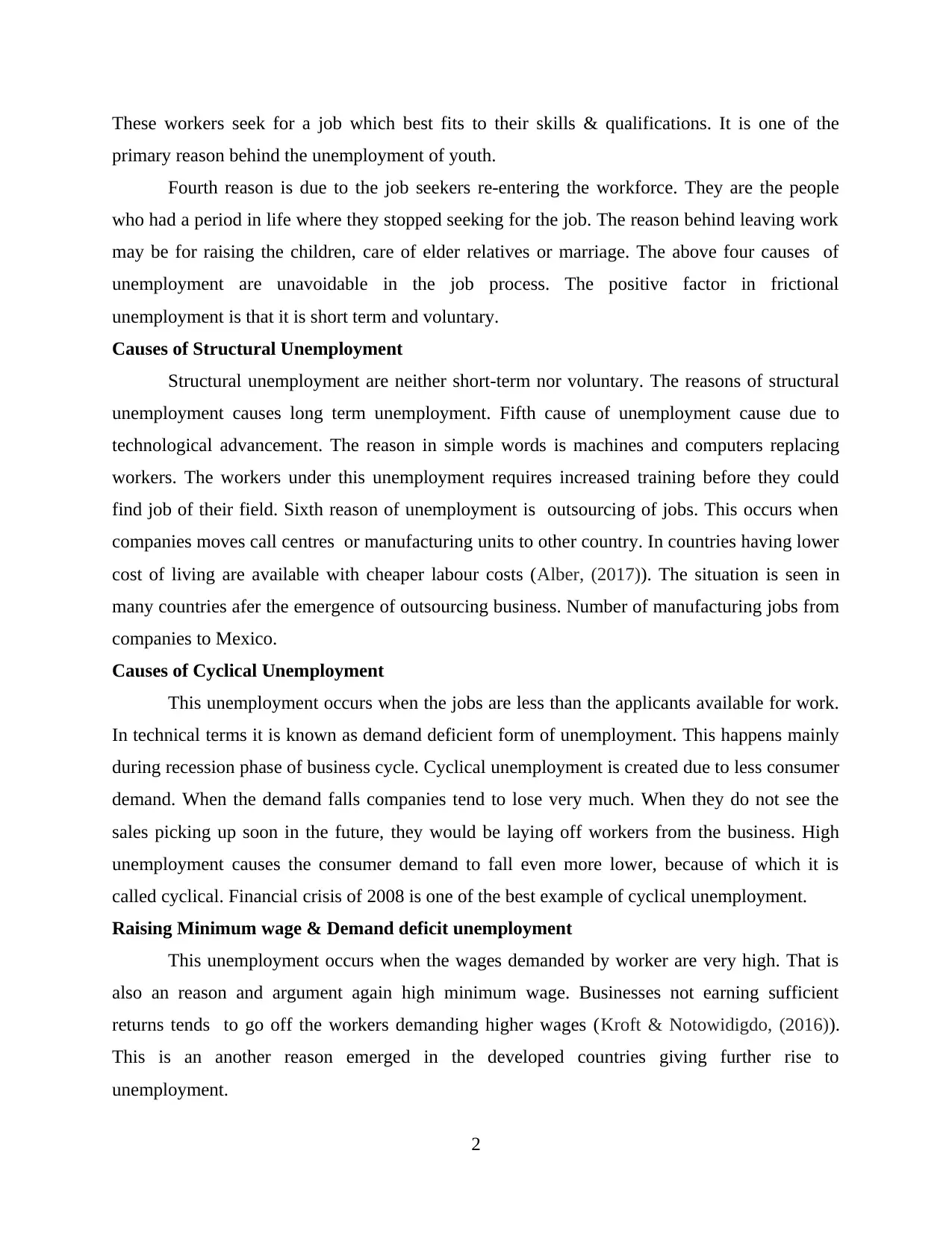
These workers seek for a job which best fits to their skills & qualifications. It is one of the
primary reason behind the unemployment of youth.
Fourth reason is due to the job seekers re-entering the workforce. They are the people
who had a period in life where they stopped seeking for the job. The reason behind leaving work
may be for raising the children, care of elder relatives or marriage. The above four causes of
unemployment are unavoidable in the job process. The positive factor in frictional
unemployment is that it is short term and voluntary.
Causes of Structural Unemployment
Structural unemployment are neither short-term nor voluntary. The reasons of structural
unemployment causes long term unemployment. Fifth cause of unemployment cause due to
technological advancement. The reason in simple words is machines and computers replacing
workers. The workers under this unemployment requires increased training before they could
find job of their field. Sixth reason of unemployment is outsourcing of jobs. This occurs when
companies moves call centres or manufacturing units to other country. In countries having lower
cost of living are available with cheaper labour costs (Alber, (2017)). The situation is seen in
many countries afer the emergence of outsourcing business. Number of manufacturing jobs from
companies to Mexico.
Causes of Cyclical Unemployment
This unemployment occurs when the jobs are less than the applicants available for work.
In technical terms it is known as demand deficient form of unemployment. This happens mainly
during recession phase of business cycle. Cyclical unemployment is created due to less consumer
demand. When the demand falls companies tend to lose very much. When they do not see the
sales picking up soon in the future, they would be laying off workers from the business. High
unemployment causes the consumer demand to fall even more lower, because of which it is
called cyclical. Financial crisis of 2008 is one of the best example of cyclical unemployment.
Raising Minimum wage & Demand deficit unemployment
This unemployment occurs when the wages demanded by worker are very high. That is
also an reason and argument again high minimum wage. Businesses not earning sufficient
returns tends to go off the workers demanding higher wages (Kroft & Notowidigdo, (2016)).
This is an another reason emerged in the developed countries giving further rise to
unemployment.
2
primary reason behind the unemployment of youth.
Fourth reason is due to the job seekers re-entering the workforce. They are the people
who had a period in life where they stopped seeking for the job. The reason behind leaving work
may be for raising the children, care of elder relatives or marriage. The above four causes of
unemployment are unavoidable in the job process. The positive factor in frictional
unemployment is that it is short term and voluntary.
Causes of Structural Unemployment
Structural unemployment are neither short-term nor voluntary. The reasons of structural
unemployment causes long term unemployment. Fifth cause of unemployment cause due to
technological advancement. The reason in simple words is machines and computers replacing
workers. The workers under this unemployment requires increased training before they could
find job of their field. Sixth reason of unemployment is outsourcing of jobs. This occurs when
companies moves call centres or manufacturing units to other country. In countries having lower
cost of living are available with cheaper labour costs (Alber, (2017)). The situation is seen in
many countries afer the emergence of outsourcing business. Number of manufacturing jobs from
companies to Mexico.
Causes of Cyclical Unemployment
This unemployment occurs when the jobs are less than the applicants available for work.
In technical terms it is known as demand deficient form of unemployment. This happens mainly
during recession phase of business cycle. Cyclical unemployment is created due to less consumer
demand. When the demand falls companies tend to lose very much. When they do not see the
sales picking up soon in the future, they would be laying off workers from the business. High
unemployment causes the consumer demand to fall even more lower, because of which it is
called cyclical. Financial crisis of 2008 is one of the best example of cyclical unemployment.
Raising Minimum wage & Demand deficit unemployment
This unemployment occurs when the wages demanded by worker are very high. That is
also an reason and argument again high minimum wage. Businesses not earning sufficient
returns tends to go off the workers demanding higher wages (Kroft & Notowidigdo, (2016)).
This is an another reason emerged in the developed countries giving further rise to
unemployment.
2
Paraphrase This Document
Need a fresh take? Get an instant paraphrase of this document with our AI Paraphraser
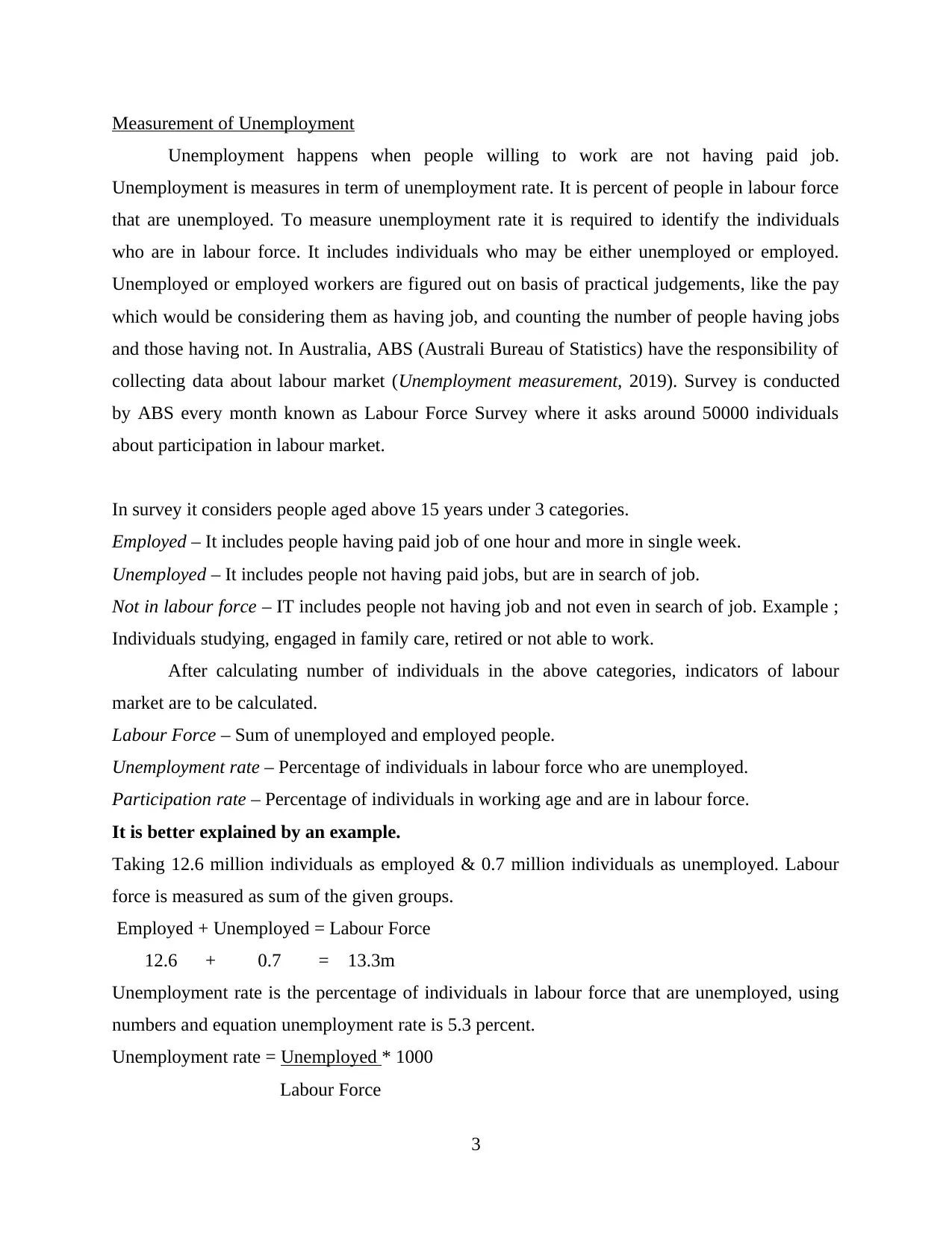
Measurement of Unemployment
Unemployment happens when people willing to work are not having paid job.
Unemployment is measures in term of unemployment rate. It is percent of people in labour force
that are unemployed. To measure unemployment rate it is required to identify the individuals
who are in labour force. It includes individuals who may be either unemployed or employed.
Unemployed or employed workers are figured out on basis of practical judgements, like the pay
which would be considering them as having job, and counting the number of people having jobs
and those having not. In Australia, ABS (Australi Bureau of Statistics) have the responsibility of
collecting data about labour market (Unemployment measurement, 2019). Survey is conducted
by ABS every month known as Labour Force Survey where it asks around 50000 individuals
about participation in labour market.
In survey it considers people aged above 15 years under 3 categories.
Employed – It includes people having paid job of one hour and more in single week.
Unemployed – It includes people not having paid jobs, but are in search of job.
Not in labour force – IT includes people not having job and not even in search of job. Example ;
Individuals studying, engaged in family care, retired or not able to work.
After calculating number of individuals in the above categories, indicators of labour
market are to be calculated.
Labour Force – Sum of unemployed and employed people.
Unemployment rate – Percentage of individuals in labour force who are unemployed.
Participation rate – Percentage of individuals in working age and are in labour force.
It is better explained by an example.
Taking 12.6 million individuals as employed & 0.7 million individuals as unemployed. Labour
force is measured as sum of the given groups.
Employed + Unemployed = Labour Force
12.6 + 0.7 = 13.3m
Unemployment rate is the percentage of individuals in labour force that are unemployed, using
numbers and equation unemployment rate is 5.3 percent.
Unemployment rate = Unemployed * 1000
Labour Force
3
Unemployment happens when people willing to work are not having paid job.
Unemployment is measures in term of unemployment rate. It is percent of people in labour force
that are unemployed. To measure unemployment rate it is required to identify the individuals
who are in labour force. It includes individuals who may be either unemployed or employed.
Unemployed or employed workers are figured out on basis of practical judgements, like the pay
which would be considering them as having job, and counting the number of people having jobs
and those having not. In Australia, ABS (Australi Bureau of Statistics) have the responsibility of
collecting data about labour market (Unemployment measurement, 2019). Survey is conducted
by ABS every month known as Labour Force Survey where it asks around 50000 individuals
about participation in labour market.
In survey it considers people aged above 15 years under 3 categories.
Employed – It includes people having paid job of one hour and more in single week.
Unemployed – It includes people not having paid jobs, but are in search of job.
Not in labour force – IT includes people not having job and not even in search of job. Example ;
Individuals studying, engaged in family care, retired or not able to work.
After calculating number of individuals in the above categories, indicators of labour
market are to be calculated.
Labour Force – Sum of unemployed and employed people.
Unemployment rate – Percentage of individuals in labour force who are unemployed.
Participation rate – Percentage of individuals in working age and are in labour force.
It is better explained by an example.
Taking 12.6 million individuals as employed & 0.7 million individuals as unemployed. Labour
force is measured as sum of the given groups.
Employed + Unemployed = Labour Force
12.6 + 0.7 = 13.3m
Unemployment rate is the percentage of individuals in labour force that are unemployed, using
numbers and equation unemployment rate is 5.3 percent.
Unemployment rate = Unemployed * 1000
Labour Force
3
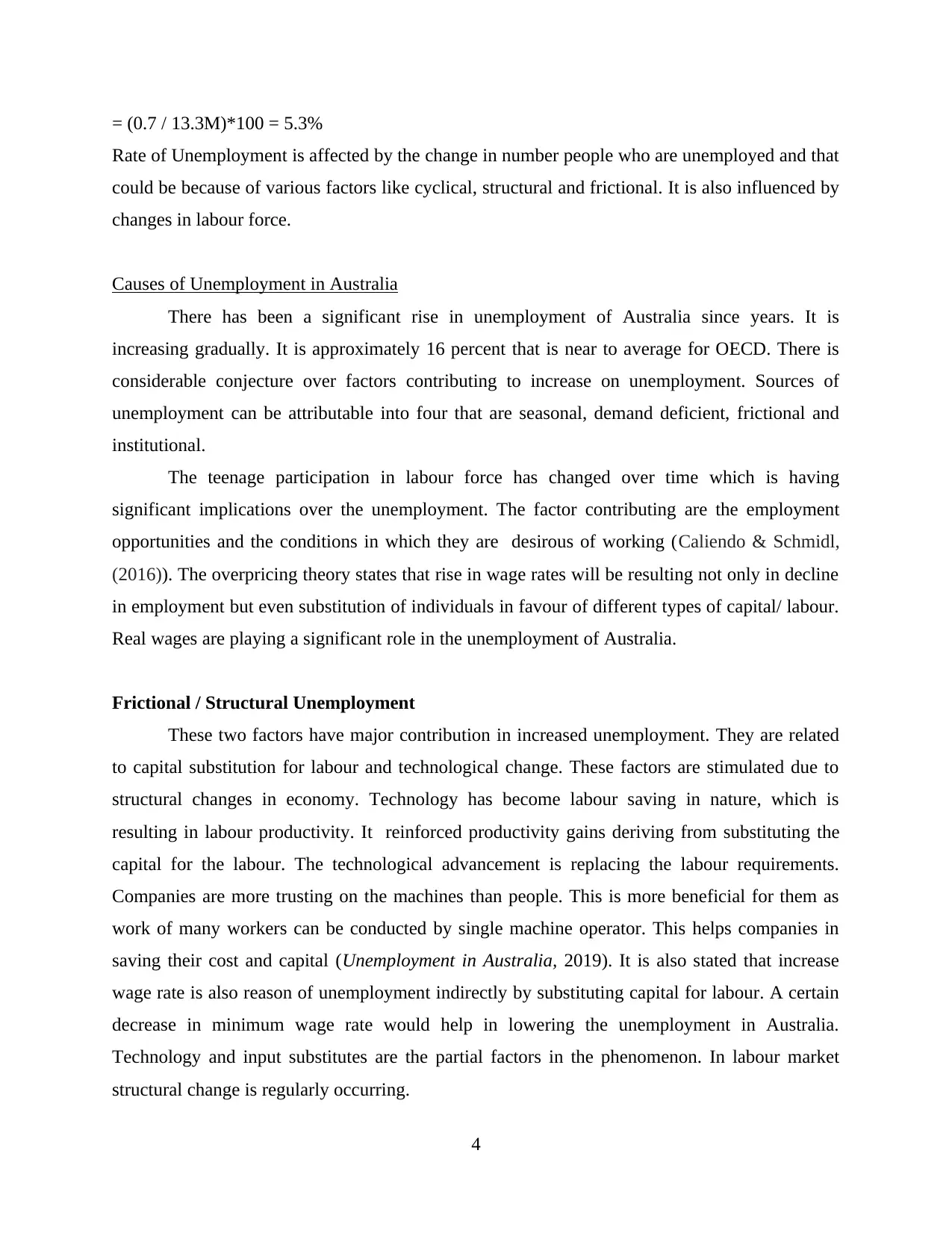
= (0.7 / 13.3M)*100 = 5.3%
Rate of Unemployment is affected by the change in number people who are unemployed and that
could be because of various factors like cyclical, structural and frictional. It is also influenced by
changes in labour force.
Causes of Unemployment in Australia
There has been a significant rise in unemployment of Australia since years. It is
increasing gradually. It is approximately 16 percent that is near to average for OECD. There is
considerable conjecture over factors contributing to increase on unemployment. Sources of
unemployment can be attributable into four that are seasonal, demand deficient, frictional and
institutional.
The teenage participation in labour force has changed over time which is having
significant implications over the unemployment. The factor contributing are the employment
opportunities and the conditions in which they are desirous of working (Caliendo & Schmidl,
(2016)). The overpricing theory states that rise in wage rates will be resulting not only in decline
in employment but even substitution of individuals in favour of different types of capital/ labour.
Real wages are playing a significant role in the unemployment of Australia.
Frictional / Structural Unemployment
These two factors have major contribution in increased unemployment. They are related
to capital substitution for labour and technological change. These factors are stimulated due to
structural changes in economy. Technology has become labour saving in nature, which is
resulting in labour productivity. It reinforced productivity gains deriving from substituting the
capital for the labour. The technological advancement is replacing the labour requirements.
Companies are more trusting on the machines than people. This is more beneficial for them as
work of many workers can be conducted by single machine operator. This helps companies in
saving their cost and capital (Unemployment in Australia, 2019). It is also stated that increase
wage rate is also reason of unemployment indirectly by substituting capital for labour. A certain
decrease in minimum wage rate would help in lowering the unemployment in Australia.
Technology and input substitutes are the partial factors in the phenomenon. In labour market
structural change is regularly occurring.
4
Rate of Unemployment is affected by the change in number people who are unemployed and that
could be because of various factors like cyclical, structural and frictional. It is also influenced by
changes in labour force.
Causes of Unemployment in Australia
There has been a significant rise in unemployment of Australia since years. It is
increasing gradually. It is approximately 16 percent that is near to average for OECD. There is
considerable conjecture over factors contributing to increase on unemployment. Sources of
unemployment can be attributable into four that are seasonal, demand deficient, frictional and
institutional.
The teenage participation in labour force has changed over time which is having
significant implications over the unemployment. The factor contributing are the employment
opportunities and the conditions in which they are desirous of working (Caliendo & Schmidl,
(2016)). The overpricing theory states that rise in wage rates will be resulting not only in decline
in employment but even substitution of individuals in favour of different types of capital/ labour.
Real wages are playing a significant role in the unemployment of Australia.
Frictional / Structural Unemployment
These two factors have major contribution in increased unemployment. They are related
to capital substitution for labour and technological change. These factors are stimulated due to
structural changes in economy. Technology has become labour saving in nature, which is
resulting in labour productivity. It reinforced productivity gains deriving from substituting the
capital for the labour. The technological advancement is replacing the labour requirements.
Companies are more trusting on the machines than people. This is more beneficial for them as
work of many workers can be conducted by single machine operator. This helps companies in
saving their cost and capital (Unemployment in Australia, 2019). It is also stated that increase
wage rate is also reason of unemployment indirectly by substituting capital for labour. A certain
decrease in minimum wage rate would help in lowering the unemployment in Australia.
Technology and input substitutes are the partial factors in the phenomenon. In labour market
structural change is regularly occurring.
4
⊘ This is a preview!⊘
Do you want full access?
Subscribe today to unlock all pages.

Trusted by 1+ million students worldwide
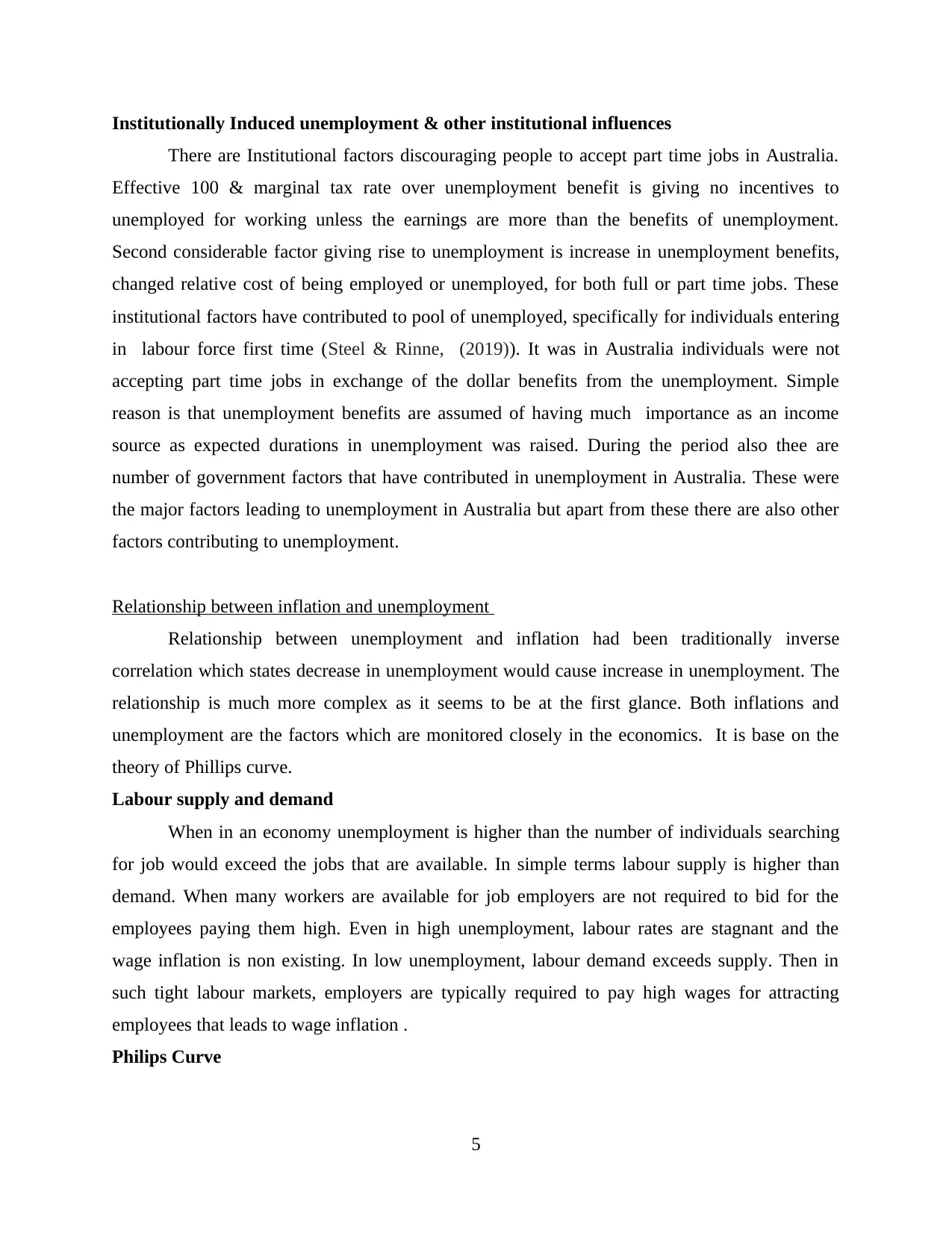
Institutionally Induced unemployment & other institutional influences
There are Institutional factors discouraging people to accept part time jobs in Australia.
Effective 100 & marginal tax rate over unemployment benefit is giving no incentives to
unemployed for working unless the earnings are more than the benefits of unemployment.
Second considerable factor giving rise to unemployment is increase in unemployment benefits,
changed relative cost of being employed or unemployed, for both full or part time jobs. These
institutional factors have contributed to pool of unemployed, specifically for individuals entering
in labour force first time (Steel & Rinne, (2019)). It was in Australia individuals were not
accepting part time jobs in exchange of the dollar benefits from the unemployment. Simple
reason is that unemployment benefits are assumed of having much importance as an income
source as expected durations in unemployment was raised. During the period also thee are
number of government factors that have contributed in unemployment in Australia. These were
the major factors leading to unemployment in Australia but apart from these there are also other
factors contributing to unemployment.
Relationship between inflation and unemployment
Relationship between unemployment and inflation had been traditionally inverse
correlation which states decrease in unemployment would cause increase in unemployment. The
relationship is much more complex as it seems to be at the first glance. Both inflations and
unemployment are the factors which are monitored closely in the economics. It is base on the
theory of Phillips curve.
Labour supply and demand
When in an economy unemployment is higher than the number of individuals searching
for job would exceed the jobs that are available. In simple terms labour supply is higher than
demand. When many workers are available for job employers are not required to bid for the
employees paying them high. Even in high unemployment, labour rates are stagnant and the
wage inflation is non existing. In low unemployment, labour demand exceeds supply. Then in
such tight labour markets, employers are typically required to pay high wages for attracting
employees that leads to wage inflation .
Philips Curve
5
There are Institutional factors discouraging people to accept part time jobs in Australia.
Effective 100 & marginal tax rate over unemployment benefit is giving no incentives to
unemployed for working unless the earnings are more than the benefits of unemployment.
Second considerable factor giving rise to unemployment is increase in unemployment benefits,
changed relative cost of being employed or unemployed, for both full or part time jobs. These
institutional factors have contributed to pool of unemployed, specifically for individuals entering
in labour force first time (Steel & Rinne, (2019)). It was in Australia individuals were not
accepting part time jobs in exchange of the dollar benefits from the unemployment. Simple
reason is that unemployment benefits are assumed of having much importance as an income
source as expected durations in unemployment was raised. During the period also thee are
number of government factors that have contributed in unemployment in Australia. These were
the major factors leading to unemployment in Australia but apart from these there are also other
factors contributing to unemployment.
Relationship between inflation and unemployment
Relationship between unemployment and inflation had been traditionally inverse
correlation which states decrease in unemployment would cause increase in unemployment. The
relationship is much more complex as it seems to be at the first glance. Both inflations and
unemployment are the factors which are monitored closely in the economics. It is base on the
theory of Phillips curve.
Labour supply and demand
When in an economy unemployment is higher than the number of individuals searching
for job would exceed the jobs that are available. In simple terms labour supply is higher than
demand. When many workers are available for job employers are not required to bid for the
employees paying them high. Even in high unemployment, labour rates are stagnant and the
wage inflation is non existing. In low unemployment, labour demand exceeds supply. Then in
such tight labour markets, employers are typically required to pay high wages for attracting
employees that leads to wage inflation .
Philips Curve
5
Paraphrase This Document
Need a fresh take? Get an instant paraphrase of this document with our AI Paraphraser
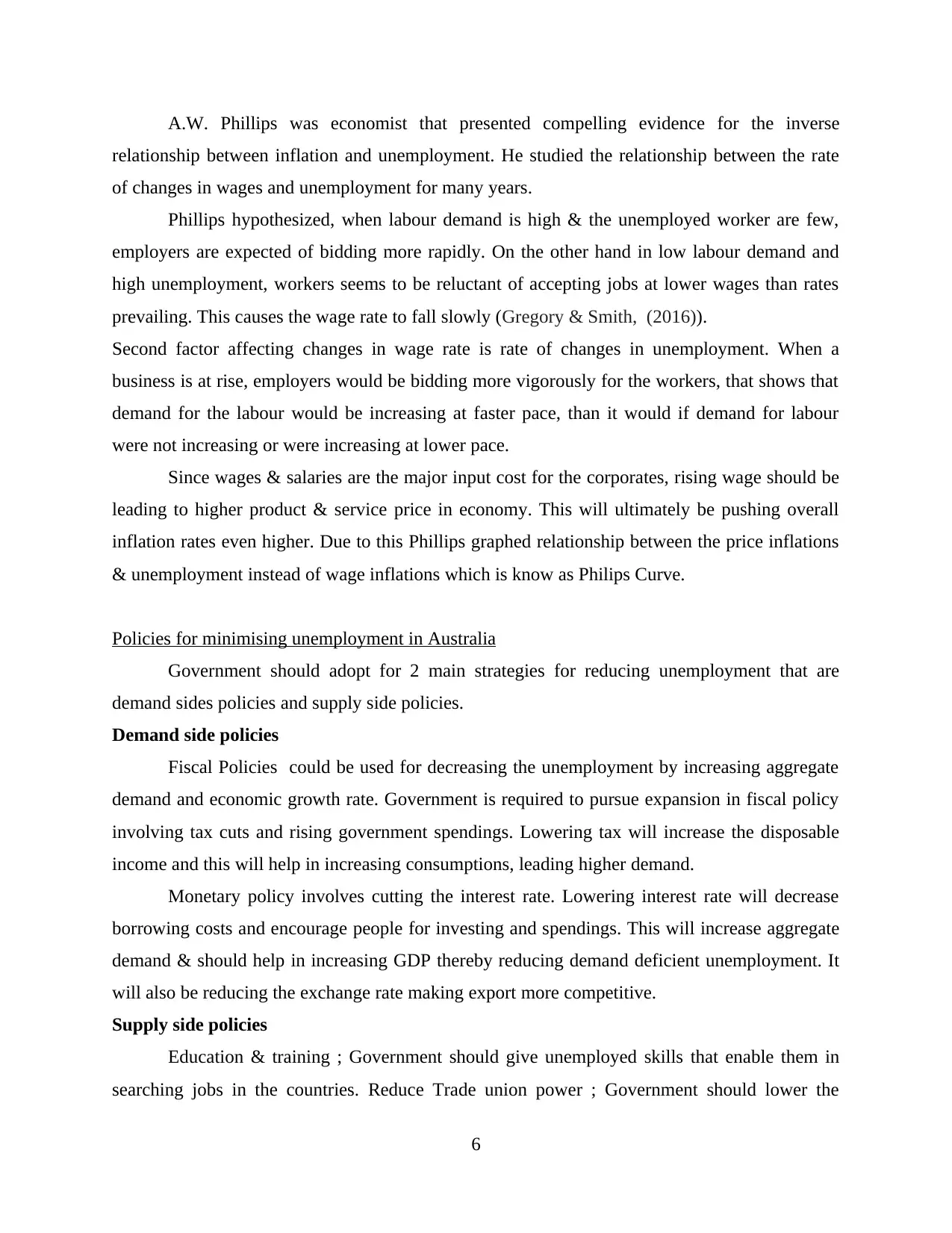
A.W. Phillips was economist that presented compelling evidence for the inverse
relationship between inflation and unemployment. He studied the relationship between the rate
of changes in wages and unemployment for many years.
Phillips hypothesized, when labour demand is high & the unemployed worker are few,
employers are expected of bidding more rapidly. On the other hand in low labour demand and
high unemployment, workers seems to be reluctant of accepting jobs at lower wages than rates
prevailing. This causes the wage rate to fall slowly (Gregory & Smith, (2016)).
Second factor affecting changes in wage rate is rate of changes in unemployment. When a
business is at rise, employers would be bidding more vigorously for the workers, that shows that
demand for the labour would be increasing at faster pace, than it would if demand for labour
were not increasing or were increasing at lower pace.
Since wages & salaries are the major input cost for the corporates, rising wage should be
leading to higher product & service price in economy. This will ultimately be pushing overall
inflation rates even higher. Due to this Phillips graphed relationship between the price inflations
& unemployment instead of wage inflations which is know as Philips Curve.
Policies for minimising unemployment in Australia
Government should adopt for 2 main strategies for reducing unemployment that are
demand sides policies and supply side policies.
Demand side policies
Fiscal Policies could be used for decreasing the unemployment by increasing aggregate
demand and economic growth rate. Government is required to pursue expansion in fiscal policy
involving tax cuts and rising government spendings. Lowering tax will increase the disposable
income and this will help in increasing consumptions, leading higher demand.
Monetary policy involves cutting the interest rate. Lowering interest rate will decrease
borrowing costs and encourage people for investing and spendings. This will increase aggregate
demand & should help in increasing GDP thereby reducing demand deficient unemployment. It
will also be reducing the exchange rate making export more competitive.
Supply side policies
Education & training ; Government should give unemployed skills that enable them in
searching jobs in the countries. Reduce Trade union power ; Government should lower the
6
relationship between inflation and unemployment. He studied the relationship between the rate
of changes in wages and unemployment for many years.
Phillips hypothesized, when labour demand is high & the unemployed worker are few,
employers are expected of bidding more rapidly. On the other hand in low labour demand and
high unemployment, workers seems to be reluctant of accepting jobs at lower wages than rates
prevailing. This causes the wage rate to fall slowly (Gregory & Smith, (2016)).
Second factor affecting changes in wage rate is rate of changes in unemployment. When a
business is at rise, employers would be bidding more vigorously for the workers, that shows that
demand for the labour would be increasing at faster pace, than it would if demand for labour
were not increasing or were increasing at lower pace.
Since wages & salaries are the major input cost for the corporates, rising wage should be
leading to higher product & service price in economy. This will ultimately be pushing overall
inflation rates even higher. Due to this Phillips graphed relationship between the price inflations
& unemployment instead of wage inflations which is know as Philips Curve.
Policies for minimising unemployment in Australia
Government should adopt for 2 main strategies for reducing unemployment that are
demand sides policies and supply side policies.
Demand side policies
Fiscal Policies could be used for decreasing the unemployment by increasing aggregate
demand and economic growth rate. Government is required to pursue expansion in fiscal policy
involving tax cuts and rising government spendings. Lowering tax will increase the disposable
income and this will help in increasing consumptions, leading higher demand.
Monetary policy involves cutting the interest rate. Lowering interest rate will decrease
borrowing costs and encourage people for investing and spendings. This will increase aggregate
demand & should help in increasing GDP thereby reducing demand deficient unemployment. It
will also be reducing the exchange rate making export more competitive.
Supply side policies
Education & training ; Government should give unemployed skills that enable them in
searching jobs in the countries. Reduce Trade union power ; Government should lower the
6

influence of trade unions as their bargains raise the wages above the market level. This will
prevent employees from being influenced when the jobs are available. Employment
subsidies ;Government should provide tax benefits to corporates taking long term unemployed
considering existing workers are not replaced for tax benefits (Golebiowska, Elnasri & Withers,
(2016)). Strict Benefit requirements ; Government should take active role to make unemployed
in accepting the jobs. They can give guarantee for public sector jobs after certain specified
period.
CONCLUSION
The above research shows that unemployment is increasing at very faster rate in the
countries. It is essential for the economy to have control over the unemployment. Three main
categories of unemployment are frictional, frictional and cyclical where serious attention is
required to be paid over structural unemployment. Government can control the increasing
unemployment by implementing demand side and supply policies.
7
prevent employees from being influenced when the jobs are available. Employment
subsidies ;Government should provide tax benefits to corporates taking long term unemployed
considering existing workers are not replaced for tax benefits (Golebiowska, Elnasri & Withers,
(2016)). Strict Benefit requirements ; Government should take active role to make unemployed
in accepting the jobs. They can give guarantee for public sector jobs after certain specified
period.
CONCLUSION
The above research shows that unemployment is increasing at very faster rate in the
countries. It is essential for the economy to have control over the unemployment. Three main
categories of unemployment are frictional, frictional and cyclical where serious attention is
required to be paid over structural unemployment. Government can control the increasing
unemployment by implementing demand side and supply policies.
7
⊘ This is a preview!⊘
Do you want full access?
Subscribe today to unlock all pages.

Trusted by 1+ million students worldwide
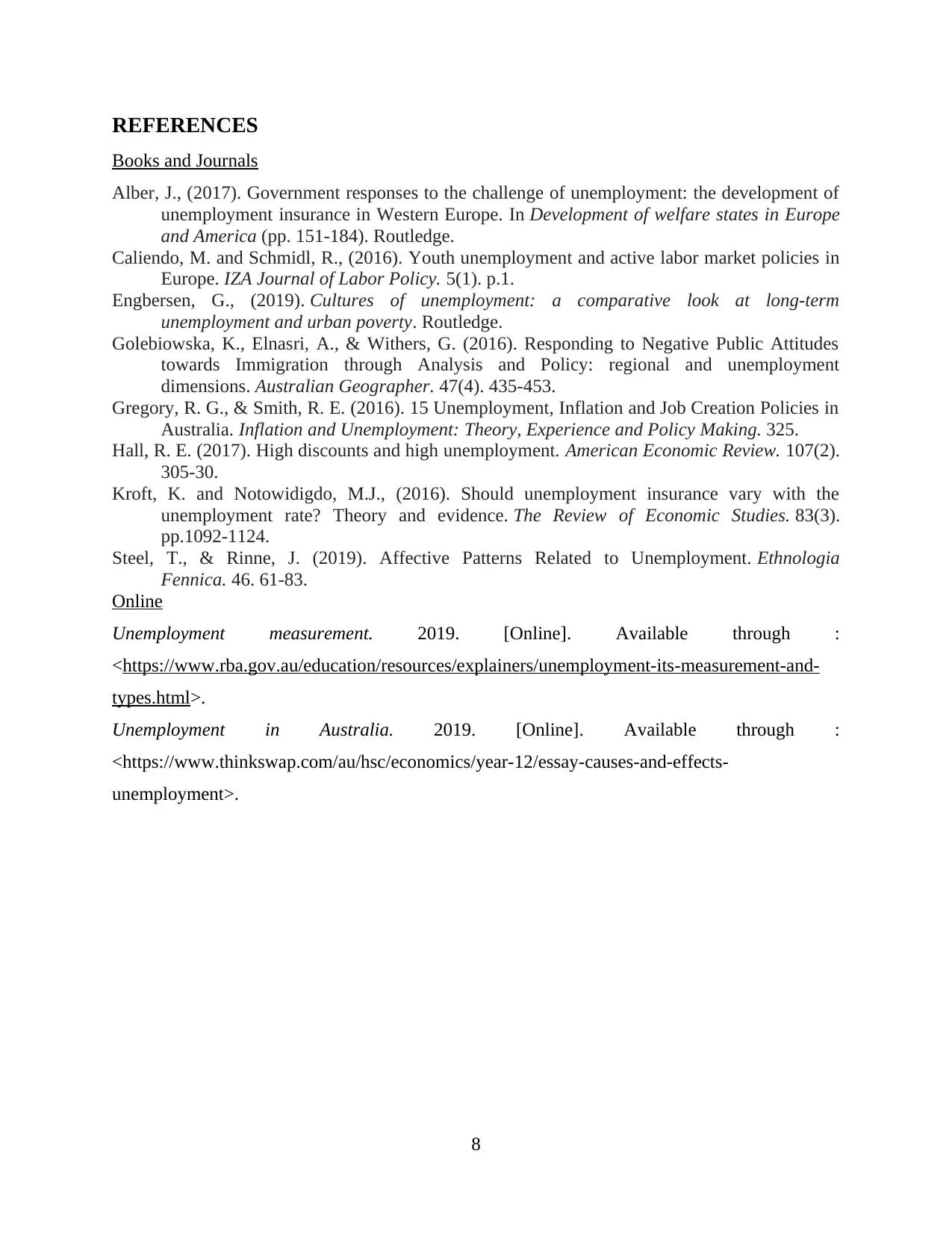
REFERENCES
Books and Journals
Alber, J., (2017). Government responses to the challenge of unemployment: the development of
unemployment insurance in Western Europe. In Development of welfare states in Europe
and America (pp. 151-184). Routledge.
Caliendo, M. and Schmidl, R., (2016). Youth unemployment and active labor market policies in
Europe. IZA Journal of Labor Policy. 5(1). p.1.
Engbersen, G., (2019). Cultures of unemployment: a comparative look at long-term
unemployment and urban poverty. Routledge.
Golebiowska, K., Elnasri, A., & Withers, G. (2016). Responding to Negative Public Attitudes
towards Immigration through Analysis and Policy: regional and unemployment
dimensions. Australian Geographer. 47(4). 435-453.
Gregory, R. G., & Smith, R. E. (2016). 15 Unemployment, Inflation and Job Creation Policies in
Australia. Inflation and Unemployment: Theory, Experience and Policy Making. 325.
Hall, R. E. (2017). High discounts and high unemployment. American Economic Review. 107(2).
305-30.
Kroft, K. and Notowidigdo, M.J., (2016). Should unemployment insurance vary with the
unemployment rate? Theory and evidence. The Review of Economic Studies. 83(3).
pp.1092-1124.
Steel, T., & Rinne, J. (2019). Affective Patterns Related to Unemployment. Ethnologia
Fennica. 46. 61-83.
Online
Unemployment measurement. 2019. [Online]. Available through :
<https://www.rba.gov.au/education/resources/explainers/unemployment-its-measurement-and-
types.html>.
Unemployment in Australia. 2019. [Online]. Available through :
<https://www.thinkswap.com/au/hsc/economics/year-12/essay-causes-and-effects-
unemployment>.
8
Books and Journals
Alber, J., (2017). Government responses to the challenge of unemployment: the development of
unemployment insurance in Western Europe. In Development of welfare states in Europe
and America (pp. 151-184). Routledge.
Caliendo, M. and Schmidl, R., (2016). Youth unemployment and active labor market policies in
Europe. IZA Journal of Labor Policy. 5(1). p.1.
Engbersen, G., (2019). Cultures of unemployment: a comparative look at long-term
unemployment and urban poverty. Routledge.
Golebiowska, K., Elnasri, A., & Withers, G. (2016). Responding to Negative Public Attitudes
towards Immigration through Analysis and Policy: regional and unemployment
dimensions. Australian Geographer. 47(4). 435-453.
Gregory, R. G., & Smith, R. E. (2016). 15 Unemployment, Inflation and Job Creation Policies in
Australia. Inflation and Unemployment: Theory, Experience and Policy Making. 325.
Hall, R. E. (2017). High discounts and high unemployment. American Economic Review. 107(2).
305-30.
Kroft, K. and Notowidigdo, M.J., (2016). Should unemployment insurance vary with the
unemployment rate? Theory and evidence. The Review of Economic Studies. 83(3).
pp.1092-1124.
Steel, T., & Rinne, J. (2019). Affective Patterns Related to Unemployment. Ethnologia
Fennica. 46. 61-83.
Online
Unemployment measurement. 2019. [Online]. Available through :
<https://www.rba.gov.au/education/resources/explainers/unemployment-its-measurement-and-
types.html>.
Unemployment in Australia. 2019. [Online]. Available through :
<https://www.thinkswap.com/au/hsc/economics/year-12/essay-causes-and-effects-
unemployment>.
8
1 out of 10
Related Documents
Your All-in-One AI-Powered Toolkit for Academic Success.
+13062052269
info@desklib.com
Available 24*7 on WhatsApp / Email
![[object Object]](/_next/static/media/star-bottom.7253800d.svg)
Unlock your academic potential
Copyright © 2020–2025 A2Z Services. All Rights Reserved. Developed and managed by ZUCOL.




